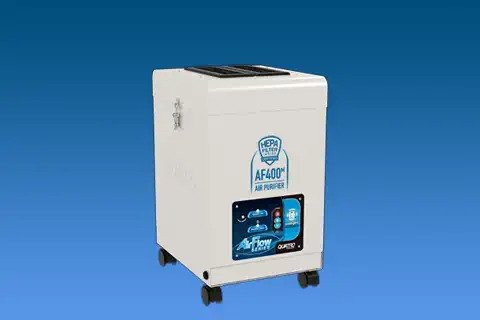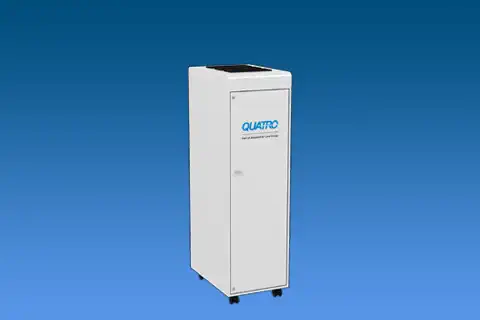Hospitals & Healthcare
Overview
 Hospitals and healthcare facilities fulfill the important function of caring for our sick population on a daily basis. As places of healing and recovery, it is imperative that healthcare institutions maintain excellent indoor air quality (IAQ) to ensure the best outcomes for patients.
Hospitals and healthcare facilities fulfill the important function of caring for our sick population on a daily basis. As places of healing and recovery, it is imperative that healthcare institutions maintain excellent indoor air quality (IAQ) to ensure the best outcomes for patients.
Many hospitals unfortunately fall short due to budgetary concerns and, as a result, fail to address the need for effective ventilation and filtration. The problem is compounded by the fact that most public hospital buildings were built many years ago with antiquated heating, ventilation and air conditioning (HVAC) systems that have yet to be updated. In an effort to find a low budget solution, hospitals will often install low-cost filters that do little to protect their staff and patients from indoor air pollution.
The result is both costly for hospitals and damaging to the health of staff and patients. Poor air quality can contribute to a number of adverse health effects such as asthma and allergies as well as nosocomial infections (those not present previous to hospital admission). And just as poor IAQ leads to negative health outcomes, good air quality helps promote positive ones and prevents further infections.
Along with the numerous health benefits, installing efficient, long-life air filters provides financial incentives by lowering energy costs long-term. A study out of California also proved that addressing IAQ can decrease hospital spending by reducing pollution-related illnesses.
Air Quality Challenges
Maintaining acceptable IAQ in a healthcare setting is no small challenge. A number of pollutants that originate from both outside and inside the hospital have the potential to contaminate indoor air. The main toxic offenders affecting IAQ in hospitals include:
- Mercury
- Polyvinyl Chloride (PVC), Dioxin and Volatile Organic Compounds (VOCs)
- Outdoor Pollution
- Infectious Disease
Mercury
Found in hospital devices such as thermometers, blood pressure cuffs and thermostats, mercury is a neurotoxin that can negatively impact the brain, liver, kidneys, central nervous and respiratory systems. If a mercury-containing device is broken, not carefully handled or stored without proper ventilation, mercury can leak out and emit toxic vapors contaminating indoor air. Once inhaled, mercury vapors can enter the lungs and later be absorbed into the bloodstream.
Because mercury is so toxic to humans, the Occupational Safety and Health Administration (OSHA) has set the legal enforceable ceiling limit for workplace exposure at 100 micrograms per cubic meter (µg/m3 ). At no point during the workday should the concentration of mercury vapors exceed this level.
Polyvinyl Chloride (PVC), Dioxin and Volatile Organic Compounds (VOCs)
Polyvinyl Chloride (PVC) is a plastic used in a number of medical supplies such as IV bags and surgical tubing. Considered by Greenpeace to be the most environmentally damaging plastic in existence, PVC poses serious risks to human health as well.
Many hospitals incinerate their waste onsite. Burning medical waste that contains PVC produces the dangerous chemical dioxin. If inhaled, dioxin can cause cancer as well as reproductive and developmental problems, immune system damage and hormone issues.
Off gassing is also a concern as PVC can release volatile organic compounds (VOCs) into the air. Dangerous if inhaled, exposure to VOC can cause fatigue, irritability, brain fog and eye, nose and throat irritation. High levels of VOC exposure is even more dangerous and can lead to:
- Skin Irritation
- Neurotoxic effects
- Liver toxicity
- Cancer
Other sources of VOCs in hospitals include the off gassing of furniture, carpeting, office equipment such as printers and cleaning agents. VOC levels are higher in newer buildings or freshly cleaned spaces.
Outdoor Pollution
Outdoor pollution can enter hospitals and contaminate indoor air in a number of ways.
Patients often bring particulates into the building by transporting them on their clothes, hair or skin. Hospitals located in cities are especially at risk as pollution levels tend to be higher. Ambulance and other vehicle exhaust as well as pollution from construction, industrial facilities, power plants and urban smog can infiltrate and affect IAQ. Hospitals located in rural areas also face threats to their air quality as pollen, seeds and other contaminants used in farming or raising cattle may pollute their indoor air.
Infectious Disease
Many patients infected with respiratory viruses will visit healthcare facilities to either seek treatment for the infection or for other ailments. Preventing an outbreak and keeping staff and patients safe, is a priority for any hospital.
Coughing and sneezing can propel infectious pollutants as far as 200 feet and remain airborne long enough to reach ceiling ventilation units, putting more people at risk of infection. Patients that are immunocompromised remain the most in danger for adverse reactions due to airborne pathogens.
To contain infectious diseases and prevent their spread, hospitals can install negative and positive pressure rooms.
A negative pressure room uses a HEPA air purifier to create lower air pressure inside a room to trap and keep potentially harmful particles from leaving. Negative pressure rooms are an effective way to isolate people with infectious diseases and protect others outside the room from exposure. They are commonly used for:
- Waiting areas
- Triage Areas
- Bathrooms
- Airborne Infection Isolation Rooms
- Autopsy and Dark Rooms
- Soiled Laundry Areas
- Decontamination Spaces
Positive pressure rooms have higher pressure inside the room so air can leave but not circulate back in. Any germs or airborne particles will be filtered out and any harmful pollutants will be prevented from coming back in so the patient in the room is protected. They are generally used for patients who are vulnerable to infectious diseases such as those with compromised immune systems. They are also used for:
- Operating Theaters
- Nurseries
- In Vitro Fertilization Labs
Solutions for Hospitals & the Healthcare Industry
To keep patients safe and promote healing, hospitals need to address their IAQ. HEPA air purifiers along with the creation of negative and positive pressure rooms are an effective way to control hazardous air pollutants and protect patients and staff.

AF 400MNP
HEPA Air Purifier
Recirculation or negative pressure-ready. Up to 280 CFM nominal air flow.
Part Number#: AF400MNP
>> View Product Details

AF 1000MNP
HEPA Air Purifier
Recirculation or negative pressure-ready. Up to 500 CFM nominal air flow.
Part Number#: AF1000MNP
>> View Product Details

AF 2000MNP
HEPA Air Purifier
Recirculation or negative pressure-ready. Up to 1000 CFM nominal air flow.
Part Number#: AF2000MNP
>> View Product Details